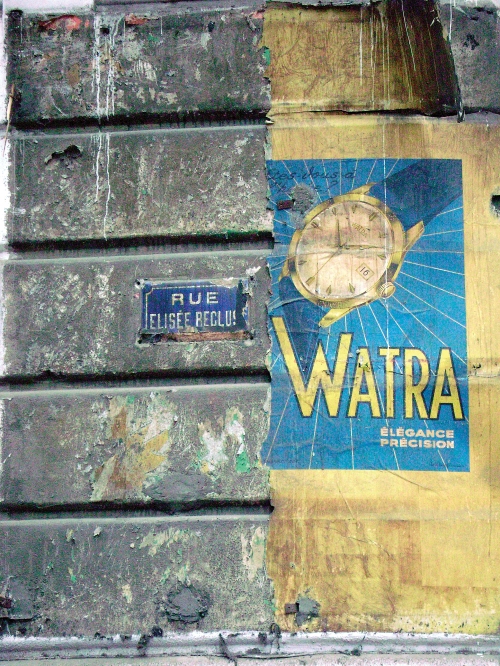
© Réda Samy Zazoun, 2008
Hi John
I wanted to send you another link to the pied-noir poet Jean Sénac: there’s a photograph on our research project website by my friend and photographer Réda Samy Zazoun that links back to Sénac’s life:
http://www.france-algeria.net/gallery/gallery_1/rsz-05.htm
I find the texture of this image very evocative and admire the fact that Réda Samy managed to combine within one image both a French colonial street sign (not terribly unusual, in fact, in contemporary Algiers) and a pre-1962 advertisement poster: the latter only revealed because of cleaning works that took place last year.
Apart from the meditation on time that the inclusion of the watch obviously encourages, the supposed connotations of ‘élégance’ and ‘précision’ with Europeanness – facilitated by the use of French – were, of course, not merely of incidental importance for the formation of Algerian identities, either pre-1962 or in the post-colonial era. The rediscovery of this advertisement poster thus provides a fragile and ephemeral trace of the past in post-colonial Algiers but also, more prosaically, epitomises the continuing influence French language and culture still has within Algiers today.
The sense of time and of being out of kilter with time – whether literally or metaphorically – is further nurtured by the strapline just discernable at the top. Asking simply: ‘Êtes-vous à l’heure?’ – ‘Are you on time?’ – it also plays on the French for one’s watch being ‘à l’heure’: being ‘right’ or ‘keeping time’.
Such a banal incitement for viewers to purchase this product becomes something rather different when you realise that this was the road where Sénac was murdered in 1973.
Indeed, the street sign uncannily raises the spectre of his life and death: as Réda Samy reminded me, Elisée Reclus was a geographer and anarchist, and in French the word ‘reclus’ can mean ‘cloistered’ or a ‘recluse’ – chillingly foretelling the fate of Sénac himself, who by his death lived alone in a tiny cellar on this small, hidden-away street, increasingly ostracised and in fear of his life.
It’s tempting therefore to interpret the miraculous reappearance of this poster here as a return of the repressed – historically and culturally – and thus read the photograph as a strangely fitting epitaph to Sénac, whose place in the newly independent Algeria was finally deemed anachronistic by those who engineered his murder. Ultimately, it might also provide a timely warning to Algerian society: who belongs in post-colonial Algeria, who decides, and at what cost?
All the best
Joe
